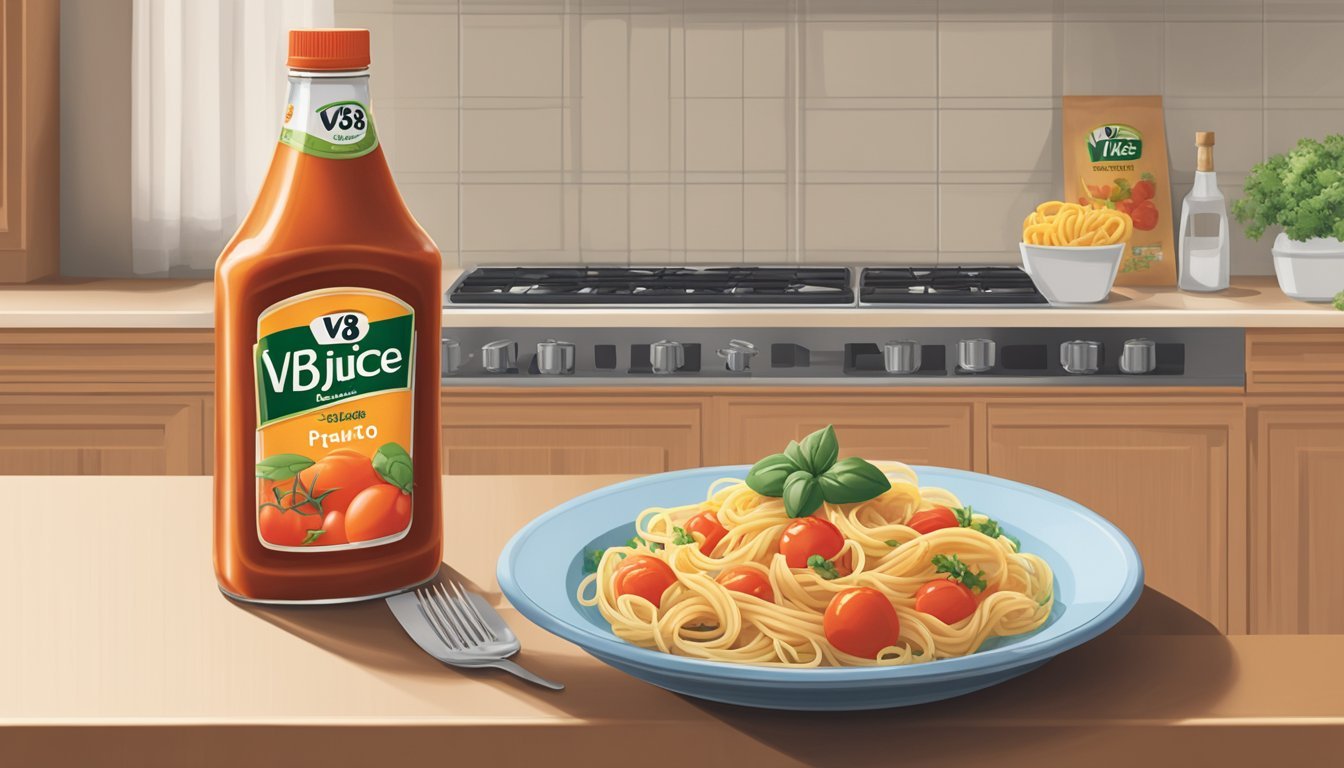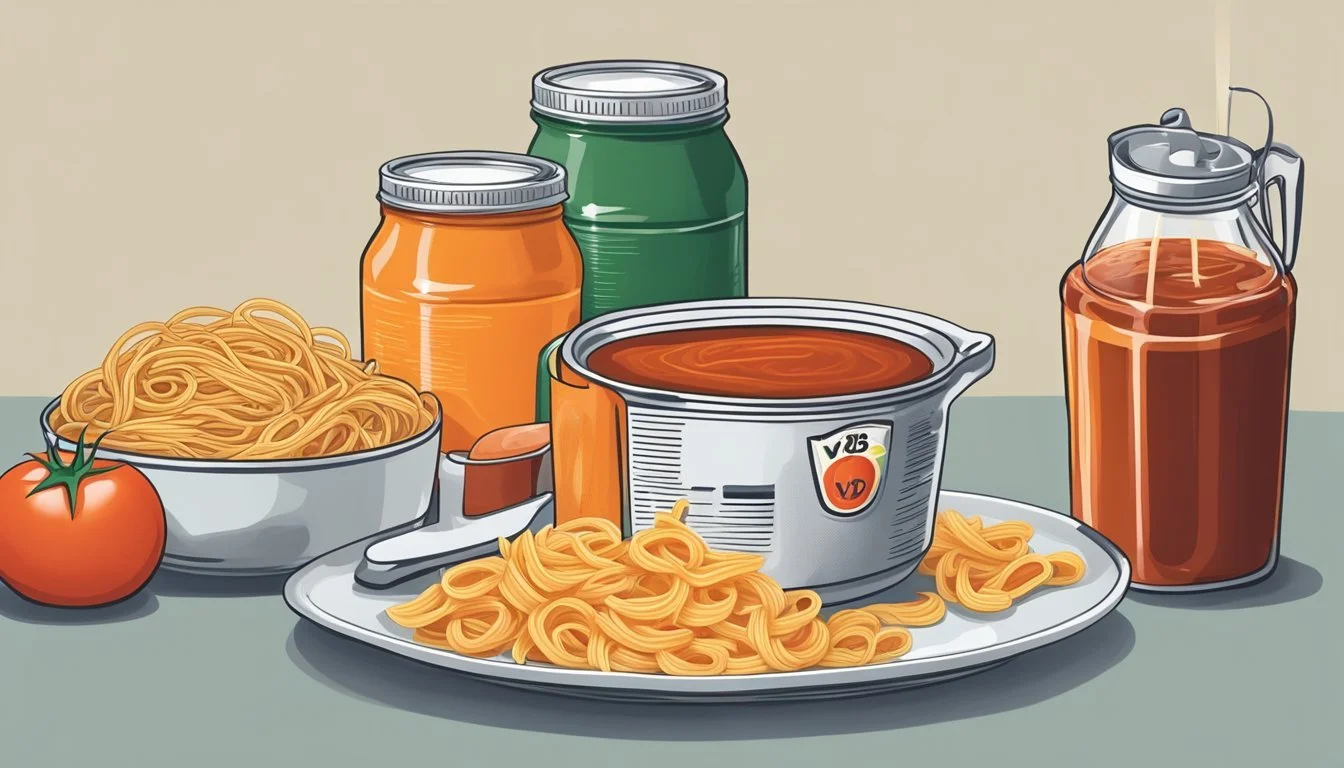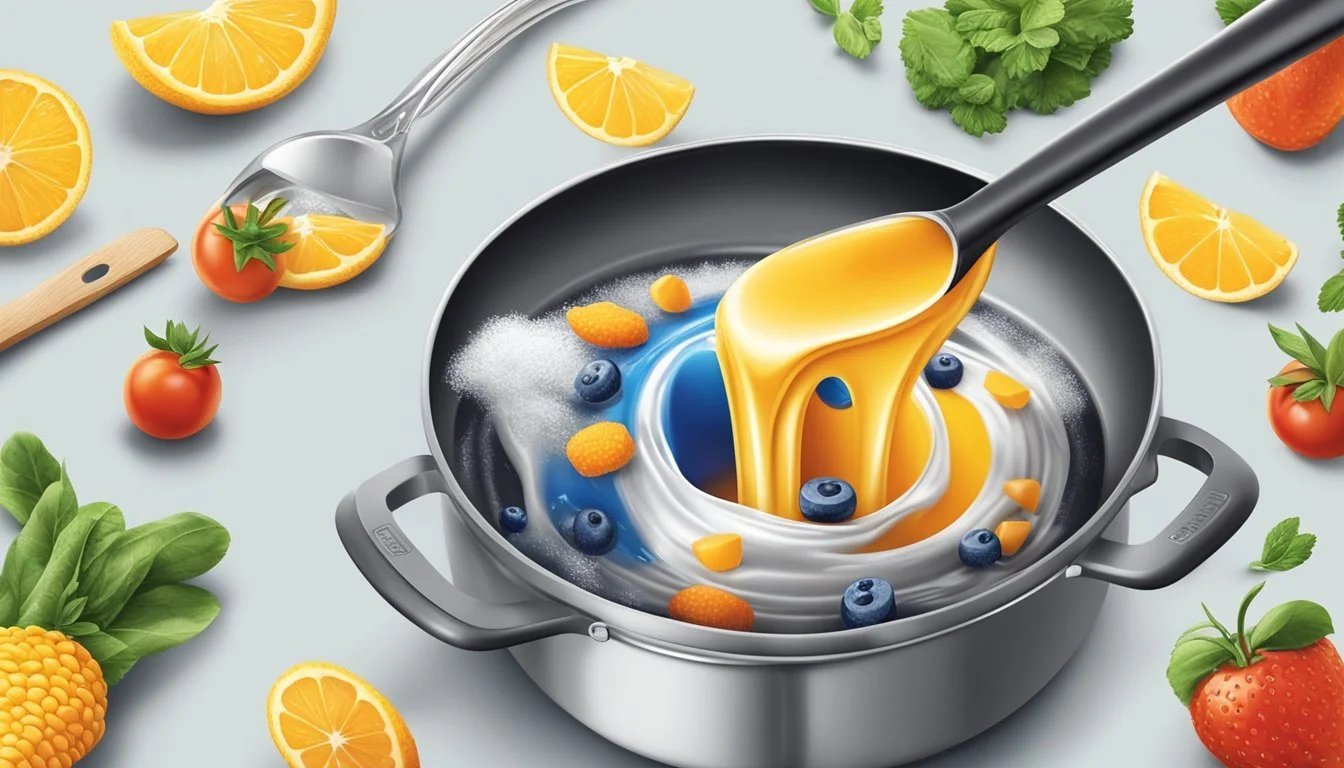How to Substitute V8 Juice for Tomato Sauce
Recipe Adaptations
Substituting V8 juice for tomato sauce in recipes is a practical solution when tomato sauce is unavailable or someone desires a variation in taste and nutritional content. V8 juice, a blend of vegetables including tomatoes (What wine goes well with tomatoes?), provides a different flavor profile and can contribute to the complexity of the dish. The key to successful substitution is understanding the differences in consistency and flavor between V8 juice and traditional tomato sauce and making appropriate adjustments during preparation.
When using V8 juice as a substitute in recipes, consider the additional flavors it brings beyond tomato, such as hints of carrot, celery (how long does celery last?), and a medley of other vegetables. These flavors can complement a variety of dishes, from pastas to stews. To achieve a consistency similar to that of tomato sauce, one may need to reduce the V8 juice or alter the amount of liquid ingredients in the recipe accordingly. It is essential to taste the dish as it cooks and adjust the seasonings to ensure a balanced and desirable flavor.
Understanding V8 Juice
V8 Juice is a well-recognized vegetable juice blend known for its unique taste and nutritional qualities. It's important to comprehend its nutritional content and flavor nuances as these are the factors that would significantly impact its role as a substitute for tomato sauce in recipes.
Nutritional Profile
V8 Juice is a concoction of various vegetables, providing a diverse range of vitamins and minerals. The beverage contains a select combination of vegetables including tomatoes, carrots, beets (how long do beets last?), celery, parsley, lettuce, watercress, and spinach. These ingredients contribute to the juice’s rich nutrients like Vitamin A and C. However, it is crucial to note that V8 can also be high in sodium, so those watching their salt intake should choose the low-sodium version when substituting for tomato sauce.
Nutrient Benefit Vitamin A Supports vision and immune function Vitamin C Antioxidant that aids in collagen production Potassium Helps regulate blood pressure
Flavor Profile
While V8 Juice does incorporate tomato juice as its base, the blend of vegetables like beet and carrots imparts a slightly sweeter and more complex taste than plain tomato sauce. The additional greens included, such as spinach and lettuce, add subtle depth, while the peppery notes of watercress and parsley offer a slight sharpness which can complement a variety of dishes. Its distinctive flavor profile is less concentrated than traditional tomato sauce, so when using it as a substitute, one should consider the context of the recipe to ensure complementary pairings.
Comparing Tomato Products
Understanding the composition and uses of various tomato products can help decide when it's appropriate to use V8 juice as a substitute for tomato sauce in recipes.
Tomato Sauce Characteristics
Tomato Sauce is a thick concoction made primarily from tomatoes, seasonings, and often has an inclusion of vegetables or meats. It's typically cooked down to concentrate flavors, which results in a rich texture and elevated taste profile. Tomato sauce is a staple ingredient in many cuisines for dishes such as pasta, lasagna, and pizza.
Vitamin Content: Higher in Vitamin E and iron
Texture: Thicker, with a smooth consistency
Flavor Profile: Deep, concentrated tomato flavor with seasoning
Sodium Content: Variably low, particularly in no-salt-added varieties
Tomato Juice and Sauce Differences
When comparing V8 Juice and Tomato Sauce, significant discrepancies arise in their nutritional composition and culinary applications. V8 juice contains a cocktail of vegetables, leading to a distinct nutritional profile.
Vitamin C: V8 juice offers 25% more of the daily Vitamin C needs than tomato sauce.
Sodium: V8 juice may contain considerably more sodium than no-salt-added tomato sauce.
Consistency: Tomato juice is more watery, which affects the texture in recipes.
Other Canned Tomato Products
An array of canned tomato products exists, each with unique characteristics making them suitable for different culinary uses. Here's a brief overview:
Tomato Paste: A highly concentrated tomato product with a deep flavor, often used in small quantities.
Canned Tomatoes: These range from whole to diced and provide a fresher tomato taste compared to concentrated products like sauce or paste.
Tomato Soup: Typically seasoned and ready to consume; it's more liquid than sauce.
Ketchup: While similar to tomato sauce in appearance, ketchup includes sweeteners and a distinct spice blend, rendering it sweeter and tangier.
Substitution Basics
When substituting V8 juice for tomato sauce, understanding the right ratios, how to adjust consistency, and adding appropriate flavors to mimic the complexity of tomato sauce are vital for a successful dish.
Substitute Ratios
V8 Juice to Tomato Sauce: Use a 1:1 ratio when substituting V8 juice for tomato sauce in recipes.
Dilution Considerations: If the V8 juice is too intense or flavorful, it can be diluted with water, starting with a ratio of 1 part water to 4 parts V8 juice, and adjusting to taste.
Adjusting Consistency
To achieve a thickness similar to that of tomato sauce, additional steps may be needed:
Thickening with Tomato Paste: For every cup of V8 juice, start with 1 tablespoon of tomato paste and incorporate more if necessary.
Reduction Method: Simmering the V8 juice on low heat can help reduce and thicken it. Monitor the viscosity and remove it from heat once the desired consistency is reached.
Adding Flavor and Acidity
Enhance the V8 juice to closely match the complexity of tomato sauce by incorporating the following:
Herbs and Spices:
Basil: (how long does basil last?) Add 1/2 teaspoon of dried basil or a couple of fresh leaves per cup of V8 juice.
Oregano: Sprinkle in 1/2 teaspoon of dried oregano to infuse the V8 juice with this classic flavor.
Seasonings:
Garlic or Onion Powder: A pinch of either can introduce more depth.
Olive Oil: A teaspoon of olive oil per cup of V8 can add richness.
Sweetness and Tanginess:
Sugar: If the V8 is too tart, balance it with a pinch of sugar.
Vinegar or Lemon Juice: To enhance acidity, a small splash of vinegar or lemon juice can be used, but sparingly, as V8 is already quite tangy.
Recipe Adaptation
When substituting V8 juice for tomato sauce in recipes, it's critical to consider the flavor profiles and consistency that the original sauce brings to the dish. V8 juice adds a complex combination of flavors from a variety of vegetables, which can enhance or alter the intended taste of your recipe.
Pasta Sauce Applications
In terms of pasta sauce, whether it's a simple marinara or a more complex arrabbiata, the consistency of V8 can be slightly thinner than traditional tomato sauce. Chefs might thicken V8 by simmering it to reduce the liquid content or by adding tomato paste to achieve the desired thickness. It is recommended to taste the sauce and adjust seasonings accordingly due to V8's vegetable blend which includes notes beyond just tomato.
To adjust V8 for spaghetti sauce:
Thicken: Simmer V8 until reduced by 1/4 or incorporate 1-2 tablespoons of tomato paste.
Season: Taste and add Italian seasoning, garlic, or salt and pepper as needed.
The key is to strive for a balance where the V8 complements rather than overwhelms the dish.
Casserole and Chili
For casseroles and chili, V8 juice can introduce a depth of flavor that might be unexpected but pleasant. Since these dishes often involve longer cooking times, the juice will have ample time to meld with other ingredients, and its thinner consistency is less of an issue.
To modify V8 for casserole use:
Use V8 in equal measure to tomato sauce.
If a thicker consistency is desired, consider mixing in a small amount of cornstarch diluted in water.
In chili, V8 provides a hearty vegetable base that complements the spices and meat.
Soups and Stews
V8 juice works excellently in soups and stews as it contributes a rich vegetable base and a smooth texture. The variety of flavors in V8 can enhance the overall profile of the dish.
For soup or stew where tomato sauce is called for:
Use V8 juice in a 1:1 ratio.
Evaluate the consistency after the initial addition and thicken with tomato paste as needed.
Remember that while V8 juice can stand in for pizza sauce, it lacks the traditional thickness and consistency; it's best to thicken and reduce it with added seasonings tailored to a pizza flavor profile.
Homemade Alternatives
When looking for a homemade alternative to store-bought V8 juice or tomato sauce, the key is to understand how to build flavors and achieve the desired consistency using fresh ingredients.
Making Tomato Sauce from Scratch
One can create homemade tomato sauce with fresh tomatoes as the base. They should start by washing and coring the tomatoes. To peel, they blanch the tomatoes in boiling water for 1 to 2 minutes and then place them in cold water. The skin should peel off easily. Using a blender or food processor, they purée the peeled tomatoes to the desired consistency.
For a thicker sauce, diced canned tomatoes or crushed tomatoes may be used. If they prefer a smoother texture, stewed tomatoes or tomato passata can serve as excellent starting points. Here's a simple format to make a basic tomato sauce:
Ingredients: Fresh tomatoes (blanched and peeled), salt, herbs (basil, oregano), olive oil, garlic, onion.
Instructions:
Dice onions and garlic.
In a large saucepan, heat olive oil and sauté onions and garlic until translucent.
Add the tomato purée and herbs.
Simmer until the sauce reaches the desired thickness.
Creating Flavorful Blends
They can incorporate a variety of ingredients to mimic the complex flavors of V8 juice. Sun-dried tomatoes add a sweet-tart flavor and can be rehydrated and blended into the tomato base. Pureed bell peppers (What wine goes well with bell peppers?) bring a slight sweetness and additional nutrients to the mix. For those who want to make their own V8-style juice, using a combination of tomatoes, carrots, beets, parsley, lettuce, watercress, spinach, and celery can recreate the taste profile. Here’s an example blend, using a food processor or high-powered blender:
Ingredients: Tomato puree, pureed bell peppers, carrots, beets, parsley, lettuce, watercress, spinach, celery.
Instructions:
Combine all ingredients in a food processor or blender.
Blend until smooth.
When substituting for V8 juice in recipes, they can adjust consistency with a bit of water if the sauce is too thick, or by simmering if too thin. Using tomato ketchup or tomato passata in a pinch can add both sweetness and tanginess to dishes, though one should add water to dilute the intensity of these condiments.
By understanding the components of V8 juice, they can create a homemade sauce or blend that can stand in for the original ingredient with personalized flavors and freshness.
Additional Tips and Tricks
Incorporating V8 juice as a tomato sauce substitute in recipes calls for careful consideration regarding seasoning, sugar, and sodium content. The reader should be well-informed about how these elements can affect the final taste of their dish.
Seasoning Adjustments
When using V8 juice instead of tomato sauce, one should assess the dish’s seasoning needs. V8 juice contains a blend of vegetables and thus, may already carry flavors, like garlic and onion, that could alter the recipe's intended taste profile. Key adjustments may include:
Reducing onion and garlic: If a recipe calls for additional onion or garlic, consider lowering the amount to account for what's already in V8 juice.
Spices: V8 juice may have a milder spice profile. Adjust spices like oregano, basil, and red pepper flakes as needed.
Sodium and Sugar Content
Compared to tomato sauce, V8 juice may have different sodium and sugar levels, which could impact health concerns or dietary restrictions.
Sodium: V8 can have higher sodium content. Review the label and modify any added salt accordingly.
Sugar: Although V8 typically does not contain high fructose corn syrup, be aware of any natural sugars from the vegetables. Recipes that add sugar may need less sweetening.
Non-Traditional Substitutes
Exploring non-traditional substitutes can bring a new dimension to your dishes. If the aim is to achieve a consistency similar to tomato sauce while using V8, be mindful of alternative additions such as:
Roasted red peppers: Puréed roasted red peppers can thicken the juice and add robust flavor.
Bell peppers: For less heat, blend sweet bell peppers with V8 to maintain a rich color and texture.
Dietary Considerations
When substituting V8 juice for tomato sauce in recipes, individuals need to consider the potential impact on dietary restrictions and health goals. This includes attention to gluten content and the levels of sodium and sugars in the ingredients used.
Gluten-Free Options
V8 juice is typically gluten-free as it is made from a blend of vegetables and does not contain wheat flour or other gluten-containing ingredients. However, one should always check the label to ensure that the product has not been contaminated during the manufacturing process. Gluten-sensitive individuals must also ensure that any additional thickeners or ingredients combined with V8 juice to emulate tomato sauce do not contain gluten.
Label checking: Always verify gluten-free status on the product label.
Thickeners: When thickening V8 juice, opt for gluten-free alternatives like cornstarch or gluten-free flours.
Reducing Sodium and Sugars
The amount of sodium and sugars in V8 juice can vary between different brands and varieties. One needs to select a low-sodium version of V8 juice when substituting for tomato sauce, especially for those monitoring their salt intake. For reducing sugar content, the unsweetened version of V8 juice is preferable.
Nutrient Advice Sodium Choose low-sodium V8 juice options Sugars Prefer unsweetened V8 juice
One's choice should align with their dietary requirements, ensuring that the replacement does not compromise their health objectives.
Storage and Shelf Life
When substituting V8 juice for tomato sauce in recipes, understanding proper storage and shelf life is critical to ensure the quality and safety of the final dish.
Preserving Homemade Mixtures
For those preparing a homemade mixture intended to substitute V8 juice, it is vital to store the concoction correctly to maintain freshness. Homemade mixtures should be kept in an airtight container in the refrigerator and ideally used within 5 to 7 days. If the user notices any off odors, a change in color, or mold growth, they should discard the mixture immediately.
Canning and Freezing
Users may opt to preserve larger batches of their homemade V8 juice substitute through canning or freezing. Properly canned mixtures can be stored in a cool, dry pantry for up to a year. Before canning, one should ensure they follow food safety guidelines to prevent contamination. On the other hand, freezing the mixture extends its shelf life significantly. When freezing, individuals should leave some headspace in the container to allow for expansion, label the container with the date, and use it within six months for the best quality. It’s important to thaw the frozen mixture in the refrigerator and stir well before use.
Final Thoughts
When one chooses to substitute V8 juice for tomato sauce in cooking, they embark on a culinary adaptation that can yield tasty results. Given the similar tomato base, V8 juice can indeed serve as an alternative, providing a combination of flavors that extend beyond the single note of tomatoes.
The substitution should be executed with consideration for consistency and concentration. V8 juice, unlike tomato sauce, is more fluid and contains a mixture of other vegetable juices. Accordingly, chefs might opt to reduce the juice to thicken it and concentrate the flavor, closely mimicking the robust nature of tomato sauce.
In terms of taste, V8 adds a distinct yet harmonious vegetable profile to dishes. It's essential to consider the complexity of the added flavors; V8's combination of vegetables can enhance a recipe but also deviate from a traditional tomato sauce taste. Adjustments might be necessary to achieve the desired flavor balance:
Salt: Since V8 can be high in sodium, additional salt may be unnecessary.
Sweetness: Tomato sauce is sweeter, so the cook may add a pinch of sugar to the V8.
Table: Adjusting V8 juice seasoning
Aspect Tomato Sauce V8 Juice Adjustment Sweetness Naturally sweet Less sweet Add sugar as needed Saltiness Varies Typically higher Reduce salt in recipe
Lastly, chefs should feel confident in experimenting with V8 as a substitute, remembering that the objective is to achieve a balance that pleases the palate while respecting the integrity of the dish being prepared. The switch to V8 juice is not merely a last-minute fix but a knowledgeable and purposeful choice that reflects a cook's adaptability and creativity in the kitchen.










